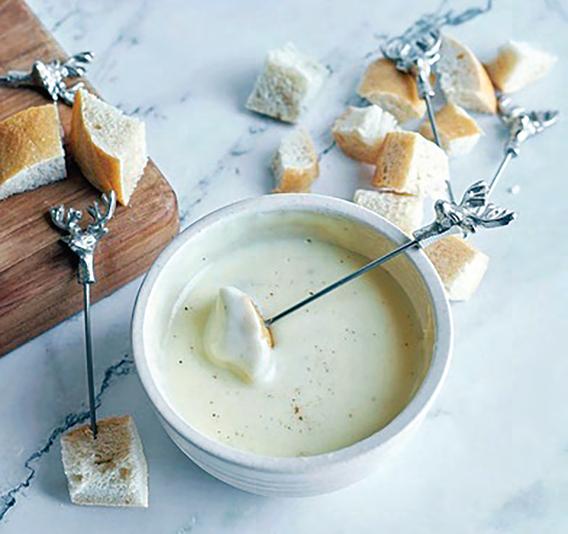
3 minute read
Dipping into Classic Cheese Fondue
By Mark Wieser
Fondue comes from the French “fonder,” meaning “to melt,” and supposedly had its origins in the 18th century Switzerland, which, as you may know, has four national official languages, one of which is French.
Advertisement
Fondue is nothing more than cheese heated with wine. The combination of water (from the wine) and water-insoluble fat (from the cheese) means that the successful fondue is an emulsion, a dispersion of microscopic droplets of fat in a water solution. That may all sound terrifyingly complex and difficult but take hope!
One really doesn’t need to know that wines with high concentrations of tartaric, malic, and citric acids, malate, tartrate and especially citrate irons are good at chelating calcium ions — just follow the recipe. Do that and your cheese fondue will be a success every time.
Fondue traces its origins to the 1700s among farm families who found ways to stretch their limited resources during harsh winters. Many Swiss farmers had cows producing lots of milk which was preserved as cheese. Many had ample supplies of aging cheeses and fresh-baked bread. Gathered around their warm kitchen tables and with a good supply of wine, Swiss families pioneered a new sensation that one day the rest of the world would consider an extraordinary and delicious way to gather with family and friends to enjoy what we call Gemütlichkeit — simply translated as a happy time. This dish actually has a deeper and more ambiguous history. It’s
Mark Wieser & Case Fischer

first mention dates to Homer’s “Iliad,” written around 800 to 725 B.C., where it was described as a mixture of goat’s cheese, wine and flour.
A 1699 cookbook called it “Käse mit Wein zu Kochen” — cheese cooked with wine became popular along the French Rhone-Alpes region near Geneva. Other versions referred to a dish composed of eggs and cheese in Vincent La Chapelle’s 1735 Fondue de Fromage aux Truffles Fraiches. Many versions were published, but by 1875, it was touted to be the Swiss national dish however it was prepared.
Those first recipes published called for Gruyére cheese, a cheese that had spread throughout the population and become a valuable export. Amazingly, most peasants could not afford it.
World War I destroyed much of the Swiss cheese industry. Exports fell by over 50% causing the Swiss to control their most precious commodity. Export without permission was prohibited. Only those farmers making Emmental, Gruyere and Sbrinz, a hard mountain cheese, were allowed. This led to the formulation of an official recipe for fondue, and in the 1930s the Swiss Cheese Union began a campaign promoting fondue as the Swiss national dish.
Fondue remained unknown in the United States until its introduction at the 1964 New York World’s Fair, a fair that I attended upon my return from a summer in Europe. I hadn’t realized that Swiss cheese fondue nor Belgium waffles were first being introduced by their countries’ exhibits as I had visited both.
I discovered Fondue Bourguignonne or beef fondue in Zürich earlier and brought home a fondue set — you may remember that recipe. Cheese Fondue appeared more appropriate for winter months.
Cheese Fondue requires a bowl that is safe for use over a Sterno can or a flame. Gruyere, Fontina and Gouda are excellent cheeses to select individually, or combine all three for a more complex flavor.
Each cheese should be grated for quicker melting and this will result in a smoother sauce.
A classic cheese fondue calls for the addition of a white wine. Choose a dry and high acid wine, such as a Sauvignon Blanc. This will keep the cheese smooth and will give it an even texture.
Stir constantly as it melts. Don’t try to rush it as you will want the mixture to melt smoothly. To complete your preparation one will need bread, preferable a French or sourdough baguette. Tear or cut into 1-inch cubes.
Apples, preferably tart ones like Granny Smith, can also be cut into cubes for dipping into the melted cheese. Cherry Tomatoes, small roasted baby potatoes, steamed broccoli, and even pickles also work well to offer guests.
After its introduction, Cheese Fondue became popular in the United States in the late 1960s and remained so well into the 1970s. It then began to fade from the American scene.
We should reconsider this. Such times make memories, provoke good conversation, and in our fast-paced world, offer quality times which today, it seems, may seldom be experienced by families.
A last word: One can find a lot of recipe variations for Cheese Fondue. This recipe is more or less the original, but always feel free to experiment.
Ingredients:
1 garlic clove
1 pound Gruyére cheese, grated
½ pound Emmentaler or other Swiss cheese, grated
1 cup dry white wine – Sauvignon Blanc
1 tablespoon fresh lemon juice
1½ tablespoons kirsch
Freshly ground pepper
Freshly grated nutmeg
Long loaves of French Bread
Preparation:
Rub the inside of a cheese fondue pot or medium enameled cast-iron casserole with garlic clove.
Combine the grated Gruyére and Emmentaler with the wine, cornstarch, and lemon juice in the fondue pot. Heat over moderate heat, stirring occasionally, until the cheeses begin to melt. (About 5 minutes.)
Add the kirsch and a generous pinch of pepper and nutmeg, stirring gently, until creamy and smooth. (About 10 minutes.)
Bring to the table, place on the fondue pot’s stand, and enjoy by spearing a piece of bread, etc., and dipping it in the cheese.
11 a.m.
WINE & SPIRITS INDUSTRY NEWS

We want our readers to take a sip of your good news! Send wine-related news of awards, new facilities, new varieties, personalities, wine makers and more to fbgnews@fredericksburgstandard.com. Cheers!










